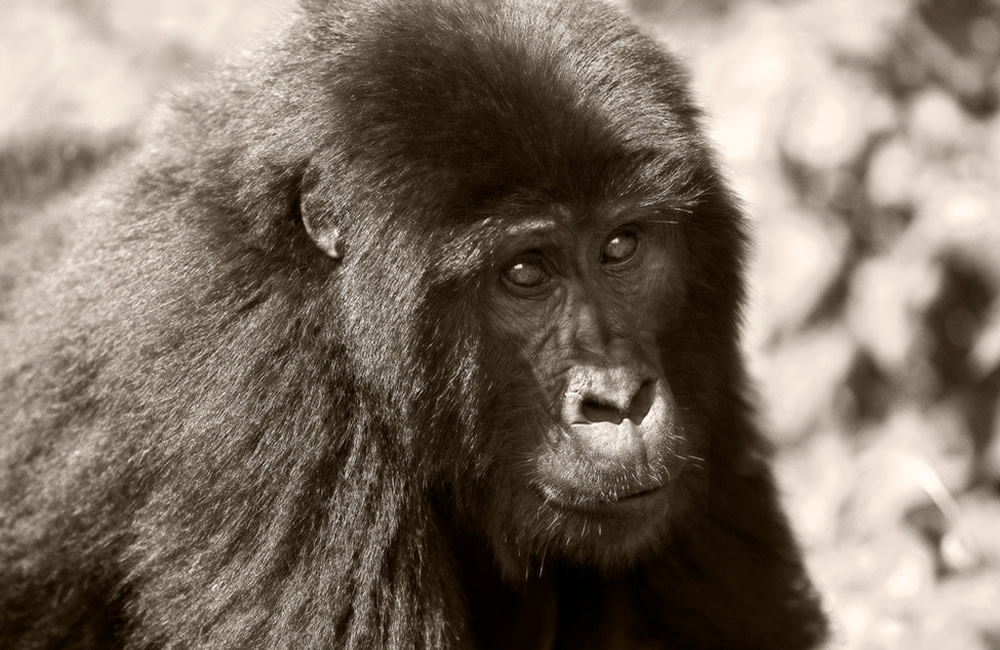Located at the junction of the plains and mountain forests, Bwindi Impenetrable National Park has been described by UNESCO as “an isolated forest of outstanding biological richness”. The ancient forest in Uganda’s mountainous south-western corner boasts an impressive biodiversity. The forest is very significant as a home to almost half of the population about 480 of the critically endangered mountain gorillas.
With over 350 species of forest birds recorded in the Park, at least 70 out of 78 montane forest bird species occurring in the Albertine Rift region are found in the forest, 310 butterflies, 200 trees, 51 reptiles, 88 moth and 120 mammals, including the rare and unforgettable mountain gorilla. Uganda, Rwanda and Democratic Republic of Congo are the only countries where it is possible to visit mountain gorillas.
Uganda’s unique tourist attraction is the endangered mountain gorilla, the bulkiest of living primates, among the most peaceable. Staring into the soft brown eyes of these gentle giants, who share 95% of their genes with humans, is as humbling as it is thrilling; no less so when one realizes that roughly 900 individuals survive, divided between Bwindi Impenetrable Forest and Virunga Mountains. Within Uganda, four habituated gorilla troops in Bwindi and 1 in Mgahinga Gorilla National Park can be visited by a total of 80 tourists daily per habituated gorilla group.
Bwindi can be accessed either by air from Entebbe Airport or Kajjansi Airstrip or by road from Kampala. From Entebbe, there are scheduled flights to Kihihi which is close to the northern sector of Bwindi and also flights to Kisoro which is close to the Southern sector of Bwindi. Flights to Kisoro only leave in the morning while Kihihi has both morning and afternoon departures from Entebbe. You can also do charter flights from Kajjansi Airstrip to either Kisoro or Kihihi.
By road, there are alternatives that include;
- Kampala-Kabale-Kanungu-Buhoma
- Kampala-Kabale-Ruhija-Buhoma
- Kampala-Kabale-Nkuringo
- Kampala-Ntungamo-Rukungiri-Kihihi-Buhoma
There is also a route that goes through Queen Elizabeth National Park via Kihihi and to Buhoma passing through the Ishasha sector of Queen Elizabeth National Park famed for the tree climbing lions. Sometimes this route is not favoured because of the bridge which keeps on breaking down.
A 3 Day gorilla photo safari in Bwindi Impenetrable Forest National Park gives you a chance to trek and stare into the eyes of endangered mountain gorillas, energetic chimpanzees and other primates. Getting into Bwindi Impenetrable Forest National Park requires a permit. The best place to get that is from the Uganda Wildlife Authority (UWA) or Nature Adventure Africa Safaris Ltd a tour operator company can also make reservations. There is no point in going to Bwindi without a permit, as you will be refused via entrance.
Tourists wishing to track gorillas must first obtain a permit at US$800 a few months prior to your gorilla tour dates because gorilla permits are so competitive with only 80 permits being issued per day to 8 people per gorilla habituated family. Selected gorilla families have been habituated to human presence, and the number of visitors is tightly controlled to prevent risks to the gorillas and degradation of the habitat.
On day one we depart for Bwindi Impenetrable Forest National Park heading south-west of Uganda. We will have a short stopover at the Uganda’s Equator for an informative talk as we as a photographic opportunity is a good chance to start exploring Uganda’s attractions. We will then continue to Mbarara at Agip Motel where we will stop for lunch. This drive will take you through Uganda rolling green hills through the highlands, also known as the ‘Switzerland of Uganda’. We then drop down into a valley to Bwindi Impenetrable Forest, home of the mountain gorillas. Overnight and dinner can be at Buhoma Lodge/ Buhoma Community Rest Camp.
Today go gorilla tracking, walking up steep densely forested hills before finally coming across the gorillas camouflaged in the vegetation, an inspiring magical moment. Trekking to see the mountain gorilla can take from 2 to 8 hours and a reasonable degree of fitness is required as well as a sturdy pair of walking boots. If you go gorilla tracking, be sure to bring a sweater, at least 2.5 litres of water, long-sleeved t-shirt/trousers, a hat, rain-clothing and decent hiking boots.
The tracking takes you through the dense rain forest, where you go up and down steep hills, often with no visible path. If it rains, it will be extremely muddy, if it’s dry and the sun is out, you will need a lot of water. Bring insect repellent for the mosquitoes, and consult your doctor for vaccinations and malaria-pills for surrounding regions. Set in the forest among the gorilla, listening to them grumble to each other, and marvel at the sheer size of the dominant male, silver back. On finding the mountain gorillas, you will be allowed 1 hour to view and take photos of these gentle apes.
It is an extraordinary feeling sitting in the dense rain forest knowing you are with a few of the last remaining mountain gorillas while taking photography of them. It is amazing to think there are only about 900 these left in the world. If you have the afternoon free, you go for a guided village walk and see how the local people live their daily life. After the experience you return back to your lodge.
Bwindi Impenetrable Forest National Park can be visit all the year. The rainy season is from March till May and October till November. Light rain season falls in November and December. Dry seasons are from December to February and June to August. The best time, the best months of the year would be December to late February and from June to September.

Leave a Reply